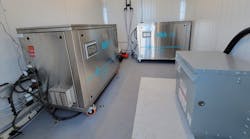While reuse wastewater has succeeded in nations such as Singapore and Namibia, it has struggled to take off in India. Facing increasing urban populations and water demands, what is holding it back? A new report from PwC hopes to reveal more.
Government intervention at a national and local level is needed to help develop water reuse schemes across India, according to a new report.
In a PwC knowledge paper - “Closing the water loop: Reuse of treated wastewater in urban India” - the organisation said there is a need for developing wastewater reuse as a sector.
Water stress has become a perennial concern in most Indian cities. India is expected to add approximately 404 million new urban dwellers between 2015 and 2050.
This rapid urban growth will be linked with higher industrial output and greater energy demand, thus adding to the urban water stress. This will lead to a domino effect, with water demand from households, industries and power plants growing simultaneously.
Such challenges are now visible in industrial metros such as Chennai, Bengaluru and Delhi, where water shortage has driven up the cost of fresh water production and industrial water tariffs.
Global experience of water reuse
Countries such as Namibia, Singapore and China were cited in the report as examples where the reuse of reclaimed water is well established. For Singapore, the frequently quoted NEWater was mentioned as a success story.
By 2060, it is estimated that approximately 70% of water demand in Singapore will be non-domestic, and NEWater capacity would be expanded to provide for 55% of total water demand. There are four NEWater plants in Singapore, with a combined production of 531,000 m3/day. In terms of the viability of the process, the cost to produce NEWater is in the range of 0.30-0.50 SGD per cubic metre, which compares to 0.50-1 SGD per cubic metre for the cost of desalination.Perhaps less high profile, China was also commended for its reuse efforts. Since 2008 Beijing has invested into reuse projects, with 22% of total water supplied in 2014 derived from reclaimed water.
Experience in India
While the Chennai Petroleum Corporation built a wastewater reuse plant in 1991, the idea has not garnered mainstream appeal since. Reuse plants have been undertaken in cities such as Nagpur, Surat and Visakhapatnam, yet these projects are still facing challenges.
PwC said this can be put down to several reasons, including a lack of clear policy environment to encourage to reuse projects. Perhaps, more importantly, the report highlighted that as there is insufficient wastewater treatment to start with, there hasn’t been much secondary treated water available for reclamation.
While on paper 80% of water supplied for domestic reuse could return as wastewater for further treatment and reuse, in reality this is difficult to achieve. Only a small fraction of wastewater generated by households is treated and available for reuse.
The way forward
“The wastewater sector will be driven by government initiatives based on which the implementation models will be designed,” said Ranen Banerjee, partner and leader public sector and governance, PwC. Moving forward, PwC recommended that to promote reuse, the central and state governments should jointly issue a national wastewater reuse policy with clear policy targets, setting out the legislative, regulatory and financial measures needed to achieve those targets.
Furthermore, the Ministry of Environment and Ministry of Water Resources should together define quality norms for different grades of industrial water which will help standardise design of reuse systems nationwide. National level norms for water safety planning and risk management are also needed to build credibility for reclaimed water as a reliable alternative.
PwC put forward three forces that are propelling the business case for reuse of treated wastewater in India.
- Water security: At present, this issue ranks high in the minds of policymakers in India with several cities facing water crises
- Reuse of treated wastewater is getting strong support from government policy. It is an important element in the ambitious plan to clean up the River Ganga, a flagship initiative of the ruling government (Clean Ganga Mission), and is also included in other urban policies and their related funding streams
- By signing the Paris Agreement on climate change in April 2016, India has signaled its concern for the sustainable use of natural resources.
Concluding and commenting on public-private-partnerships (PPP), PwC said that for PPP structures to evolve in this sector, significant government interventions are required to create a favourable environment for private sector participation.
More Water & WasteWater International Archives Issue Articles

